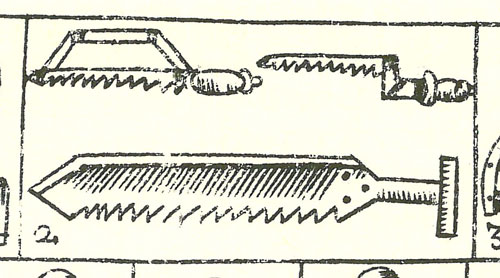
II. are again three other sorts of Saws, which are used by Wood-men.
The first is a Tennant Saw, this is a thin Saw, and therefore hath a Back of Iron to keep it from bending; it is for one hand use, and cuts forward, as all others Saws do. Some term this sort of Saw, a Faneering or Inlaying Saw, being so small and thin that the Plate of the Saw is only a flatted Wyer cut with Teeth, which is termed also a Bow Saw.
G. the like in Bend A. Handle S. born by Malkas.
The second is a Lock Saw, whose use is to make Key holes in Doors, and to Saw any hole in the middle of a Board where other Saws cannot get in: Some are made thus with a bended or square shouldering; others are streight to the handle.
This kind of Saw is by some Artificers termed a Compass Saw, because it is used to cut a round or any other Compass Kerf, and therefore the edge where the Teeth are is made broad, and the back thin, that the Back may have a wide Kerf or Nick to turn in.
O. a Stags Horn to the Sinister S. and such a Saw to the Dexter Barways G. is the Town Arms of Winlingen in Germany.
The third is a Pit Saw, or Sawyers Saw, with which great Timber is slit or Sawed into Boards, Rails, Spars, Joyce, or any other sort of Building Timber: This Saw is managed by two Men who stand one upon the Timber (called the Top-Man,) and the other under the Timber in a Pit, or laid upon Tressels, above Mans height (called the Pit-Man,) where with this large Saw they rent the Tree into what manner of Stuff the Work-man pleaseth; having an Instrument fixed at the end of the Saw, to take off, and put on at pleasure, called a Box, by help whereof he doth with ease pull the same down, and lift it up in Sawing. The Frame Saw see chap. 8. numb. 133.
— From Randle Holme’s “The Academy of Armory, or, A Storehouse of Armory and Blazon” Book III, Chapter IX. Why am I reading this